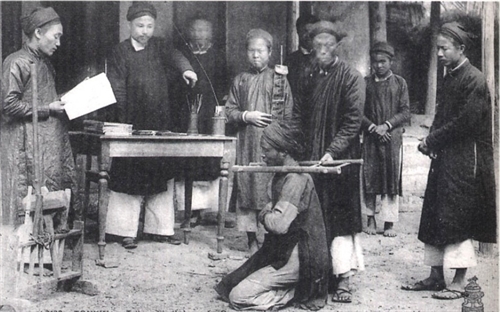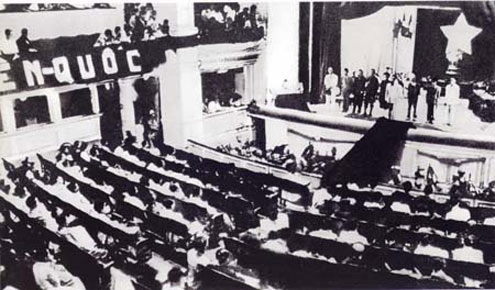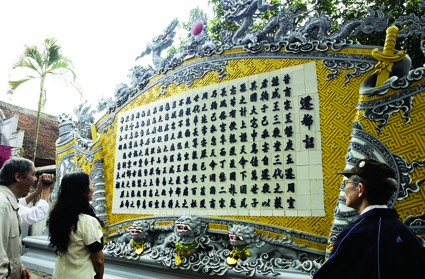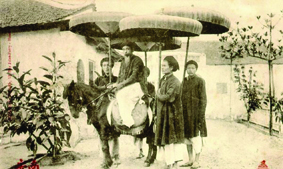Associate Prof. Dr. Nguyen Thi Viet Huong
State and Law Institute of Vietnam
Democracy
When studying the organizational institutions and operation mechanism of the ancient Vietnamese villages[1], some scholars have based themselves on the peculiar relationship between the feudal state and the villages as well as on the appreciation of the role of self-management in the villages to affirm the existence of a village democracy and the village democracy tradition in Vietnam.
Whether such village democracy tradition existed remains an issue to be further discussed. Yet, to have a correct starting point for study, it is, first of all, necessary to clearly define democracy, draw a line between democracy and self-management and determine the true nature of self-management institutions in relation to democracy.
In political and legal sciences, democracy can be understood on different planes and in different scopes. Democracy can mean the demonstration of the political outlook of a class and, in revolutionary times, it becomes the political ideal of the leading class. It can also be a political value in each society, the basic content of many crucial social elements such as culture, education, ideology, social opinion etc., through which the great capabilities of democratic and legal institutions in the realization of revolutionary missions can be clearly seen. Democracy is also perceived as a form of state regime. In this sense, democracy is synonymized with the people’s power, political freedom and equality - the principles of a political regime. Democracy, in a broader sense, is considered a category expressing the state of the political structure of society. With this meaning, democracy not only manifests itself within the state but also is a typical trait of socio-political organizations.
More specifically, according to traditional as well as current views, democracy means the people’s mastery, power belonging to the people, and a method or mechanism of social governance in which people are considered subjects of power.
So, democracy is expressed in many different ways but all forms of expression point to the core of this concept, that is the reflection of the state of enforcement of people’s political power. Democracy is always a concept of the political category, embracing such elements as capability, degree, scope and mode of exercising political power by the people. Hence, democracy is closely associated with state power, lying mainly within the scope of state power.
This perception leads to an approach to evaluating a given democracy. Such evaluation must be based on: the assessment of the capability and degree of the people’s exercise of political power (first of all state power); the assessment of scopes of exercise of political power (within the state and other scopes demonstrating the exercise at different degrees of the people’s political power); the assessment of mechanisms demonstrating the political sovereignty of the people (directly and via competent representatives); and the assessment of purposed activities of the ruling class to enable the people to exercise the political power at different degrees.
Democracy, through the abovesaid perception, differs from self-management although the two share many similarities and many forms of self-management aiming to enforce the people’s mastery inside and outside the state are concrete manifestations of democracy.
Self-management, as most commonly understood by researchers, is a form of public power where the subjects and objects of management are the same, management activities are carried out on the basis of codes of conduct developed by everyone and of the voluntary performance of collective and communal tasks (these self-managed collectives and communities are established according to certain criteria like place of residence, occupation, political view, gender etc.). Self-management may lie within the political category but it is possibly political or apolitical. Whereas, democracy is always a political concept.
So, not any form of self-management is a manifestation of democracy. Only those that demonstrate the people’s mastery and are directed toward exercise of the people’s political power are manifestations of democracy. This means that the existence of many self-management institutions does not mean the promotion of democracy. In other words, the existence of many self-management institutions is not a criterion for evaluation of the actual democratic development of a society. Neither does it mean that democracy is promoted when self-management is expanded and enhanced. On the contrary, widespread self-management can lead to anarchy detrimental to democracy. The question is that what is the nature of self-management institutions when they are considered in relation to the need for democracy promotion.
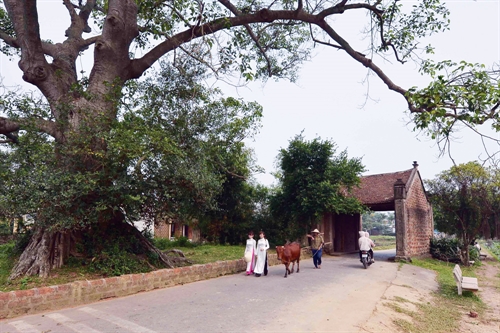 |
| The gate of Duong Lam old village in Son Tay town, Hanoi__Photo: Thanh Ha/VNA |
Whether a village democracy tradition existed in Vietnam?
To answer this question, we should examine the general picture of organizational institutions and operation mechanism of ancient Vietnamese villages, through which the true nature of self-management institutions in the villages as well as the true nature, practicality and effectiveness of mechanisms for villagers to participate in the state affairs and to exercise the state power can be clearly seen.
Looking at the structures of ancient Vietnamese villages and relationships between these structures, a number of democratic elements can be observed:
Firstly, with respect to the relationship between villages and the state, the democratic element is demonstrated in the feudal state’s recognition of the villages’ autonomy or self-management and in the relative independence enjoyed by the village administrations to decide on their village affairs (self-management of administrative affairs). In reality, besides a number of compulsory duties assigned by the state in such areas as village security, especially matters directly related to the security of the state; tax collection; mobilization of corvee labor and military conscription, the village administrations could decide by themselves on other issues on the basis of the authority delegated by the state. Under such condition, in order to run their localities, local representatives of state power sought ways and means to rely on the traditional management apparatus, namely traditional self-management bodies - “Hoi Dong Ky Muc” (Council of Elder Village Notables). So, it is the village administrations which shared their delegated administrative power with traditional management bodies. In a circumstance where existed in each village an effectively operating traditional management apparatus, the abovesaid collaboration is the only correct method of governance, and the feudal state accepted such compromised ruling method. All researches into the village history show that after trying in vain to directly control villages due to their too strong “centrifugal force”, the central feudal state had no choice but accepted the villages’ autonomy and self-management while cleverly combining grassroots administrative units with residential units under a special legal status. During their domination in Vietnam, the colonialists also recognized that reality and even made full use of it for their rule. Ancient Vietnamese villages enjoyed self-determination in various areas: organization of the village management apparatus; adoption of policies and measures for village life management; establishment and application of rules of conduct in the village (village codes); resolution of civil disputes and handling of minor criminal offenses; formation and use of village budgets; creation of a self-management system to participate in maintaining social order in villages together with the official village management apparatus etc. So, with such administrative independence and self-determination, and the coordination of state power bodies, traditional self-management bodies spared for themselves the power to decide on most internal affairs of their villages.
Secondly, looking at the intra-village relations, the democratic element was demonstrated first of all in the existence and role of “Hoi Dong Ky Muc” in the capacity as a management body set up by the villagers themselves and representing the interests of the villagers in all relevant matters. In reality, “Hoi Dong Ky Muc” played a significant role in exercising the village’s power to decide on its internal affairs as well as in supporting the village administration to fulfill obligations to the state.
Thirdly, the village democracy was also demonstrated in the way of organization and exercise of power in villages after the model of three concentric circles:
The central circle represents the village officialdom headed by the village chief elected by villagers. This body has the primary task of executing all royal orders and decisions imposed on the village in order to ensure tax revenues, corvee labor, military conscription and community security and order.
The middle circle is “Hoi Dong Ky Muc” composed of landlords and mandarins. This council is the office where decisions are discussed and made to settle village affairs and perform obligations to the state. Later, it is empowered to decide all major issues in the village and direct its assisting bodies to supervise villagers in performing their duties.
The outermost circle consists of all male villagers aged 18 years and older. As taxpayers, they are entitled to elect the village management apparatus. When “Hoi Dong Ky Muc” issues a decision, these men are summoned to the village communal house for briefing on the details of the decision and ways of implementation. For a matter that is so complicated that “Hoi Dong Ky Muc” cannot decide by itself, the men can contribute their opinions at such meeting.
So, the above organizational system divides authority and responsibility among different institutions in the village. According to general rules, all villagers have the right to elect the village chief and to participate in the settlement of village affairs.
Fourthly, the village democracy is also observed in some self-management institutions operating alongside the village management apparatus. A typical example is the “Giap” (age-based) institution, according to which male villagers of the same age form their own organization and are all equal in rights and duties, irrespective of their social position, social class, economic conditions, education. As time goes by, these villagers are promoted from the basic grade of “dinh” (when they turn 18 years old) to the grade of “lao” (elderly), the most important milestone in their life. For this equality principle, “Giap” is used by the village management when it needs consultation and assignment of communal tasks.
Fifthly, the village democracy is clearly manifest in “huong uoc” (village codes) from its drafting to enforcement. Villagers may contribute their comments through their respective “Giap” organizations on their village codes. Therefore, specific provisions of village codes more or less reflect democracy and equality. Villagers can supervise the enforcement of the village codes, especially such important provisions on division of public land, use of charity funds.... Violations of the village codes would be judged by the entire village community, employing the collective legal attitude (through public opinion, organizational measures, etc.) to compel violators to serve penalties, particularly when their violations are grave.
Some researchers consider the above-said manifestations a “village democratic regime” or “village democracy” and they even label them as democratic ideology and democratic tradition of the Vietnamese countryside. A century ago, some French scholars even held that “An Nam (former name of Vietnam) villages show us an excellent model of a constitutional administration and a representative of a form of most extremist democracy.”
However, such judgment is not really correct as it gives too much prominence to the above manifestations of democracy. When we analyze more deeply the nature of these manifestations, we can see that they are extremely limited and formalistic manifestations of democracy, which, even if combined together, are not enough to form a democracy and a village democracy tradition for several reason.
The first reason is that, in the relationship with the state, although villages are given a significant administrative self-determination to handle most of their internal village affairs, the power of the villages as a whole community only stops at this. Villages utterly had no opportunity to participate in higher-level state affairs in any form. Villagers are completely ignorant and indifferent to all happenings outside their villages. The monarchical regime was imposed from above, giving the villages not any role in the monarchy’s organization and operation. In reality, the state did not directly interfere in the internal affairs of villages, but strictly controlled them through village chiefs and censured the issuance of village codes. Villages had to obey the monarchy’s orders and all of their acts of opposition were considered illegal. In present-day’s terms, it can be said that while village inhabitants could more or less exercise their rights as masters through non-state self-management institutions, there appeared no mechanism adopted by the feudal state for its ordinary people to exercise power within the framework of the state power.
The second reason is that, as mentioned above, although “Hoi Dong Ky Muc” played a decisive role in village management, it did not truly represent the community’s common interests. It was composed of non-elected members who were retired or incumbent holders of social positions or academic degrees, military officers, and ex-district or village chiefs. Were such persons numerous in a village, only a certain number of them would be able to join “Hoi Dong Ky Muc.” If such persons were few, wealthy persons in the village could pay for the council’s membership. A “Hoi Dong Ky Muc” was headed by the village’s top notable called “Tien chi” - a person with the highest rank, position or diploma. As such, “Hoi Dong Ky Muc” was composed of only upper-class villagers and it could not be a manifestation of democracy for the vast majority of villagers.
According to general rules, plenary village meetings would be held to discuss major village affairs, such as adoption of village codes, organization of festivals and rituals, repair and renovation of communal houses and pagodas, tax collection, military conscription, and election of village chiefs. These meetings could be attended by all eligible villagers. Yet, in reality, such a meeting lost its true meaning because: (i) it was convened only when “Hoi Dong Ky Muc” could not reach a final decisions after long discussions; (ii) although eligible participants were villagers aged 18 years or older, it was not so true in reality. Only those with real or bought ranks could attend the meeting, especially when it was held to elect village chiefs; (iii) such plenary meeting mostly heard briefings on events and duties to be performed, but rarely discussed matters; and (iv) most participants either had no right to discuss or sat silent and just listened to briefings on villagers’ duties and to quarrels among dignitaries over division of benefits. This is the third reason.
The fourth reason relates to “Giap” organizations. Many researchers highly valued the role and activities of these organizations, regarding them as the explicit manifestation of village democracy. As self-management institutions, “Giap” organizations participated in many village activities and had a voice in many a few village affairs. However, democracy in Giap’s activities was merely ceremonial because: (i) “Giap” were neither election units nor village management bodies, having no final say on village affairs as their opinions and comments were only for reference by village-level state administrations. Moreover, equality only existed within Giap, but not in the whole village; (ii) issues discussed by “Giap” organizations usually aimed to assist the village management bodies in finding out solutions to performing obligations, mostly tax obligations, toward the state, but not to bring about specific economic, political and social benefits for the village community. Seeking advice from “Giap” organizations was not binding on “Hoi Dong Ky Muc” and village chiefs; and (iii) in a “Giap” meeting, most members adopted a passive attitude without participating in discussions. They just listened and nodded.
The fifth reason is that although many other self-management institutions such as residential quarters, family lines, factions and guilds also existed in villages, they were not institutions for exercise of the people’s power. These institutions were founded and functioned merely to satisfy various needs of peasants for get-togethers. Their existence was not a manifestation of democracy.
From the above analysis of the “democratic” elements in ancient Vietnamese villages, we can draw a conclusion that in ancient Vietnamese society, there was no village democracy, but only dim manifestations of a formalistic democracy, a social class-based one, which just gave rise to the abuse of power by the upper class in villages and the concession and self-denial by most villagers. These manifestations were not enough to create a tradition of democracy in the villages.
 |
| Tranquil beauty of Hoi An ancient town__Photo: Thanh Ha/VNA |
The non-existence of a democracy tradition hinders the current process of practicing and promoting grassroots democracy
In present-day Vietnamese society, promotion of democracy is not only a goal but also a practical urgent demand. Satisfaction of this demand, first of all for grassroots-level democracy, is decisive to the success of the revolutionary cause in the new period. This has been fully grasped by the Communist Party of Vietnam in its guidelines set out in Directive No. 30-CT/TW of February 18, 1998, on formulation and implementation of regulations on grassroots democracy. That Directive was institutionalized by the National Assembly Standing Committee in Resolution No. 45-1998/NQ-UBTVQH of February 26, 1998, on practice of democracy in communes, wards and townships. In that spirit, the Government on May 11, 1998, issued Decree No. 29-ND/CP promulgating the Regulation on practice of democracy in communes.
After five years’ implementation of Decree No. 29-ND/CP, on March 18, 2002, the Party Central Committee issued Resolution No. 17/NQ-TW on renewal of the grassroots political system in communes, wards and townships and on March 28, 2002, the Party Secretariat issued Directive No. 10-CT/TW, on continued formulation and implementation of grassroots regulations in communes. the Government issued a new regulation on practice of democracy in communes, together with Decree No. 79/2003/ND-CP of July 7, 2003, replacing Decree No. 29-ND/CP.
In 2007, the National Assembly Standing Committee passed an ordinance on practice of democracy in communes, wards and townships, superseding Decree No. 79/2003/ND-CP. So far, this Ordinance has served as a legal foundation for the practice of democracy at the commune level.
Regarding the question of democracy in the Vietnamese countryside in general and the contents of the 2007 Ordinance in particular, much remains to be discussed. However, the key question now concerns not only the improvement of legal institutions but also the creation of guarantees for the practice of democracy besides the guidelines for people to exercise their democratic rights.
So, in order to make a substantive improvement in the practice of democracy at the grassroots level, breakthrough solutions are needed to create a premises for the thorough settlement of latent problems in the operating mechanism of grassroots democracy. In the immediate future, there are two most crucial knots to be untied.
The first is to restructure the rural communal society, focusing on clear distinction between state administration and self-management, including economic self-management and community self-management. The functions, tasks and powers of rural institutions in the current social management should be clearly determined while mechanisms for the operation of every institution be created.
It is also necessary to re-design the organizational model of local administrations, clearly defining the power and further clarifying the roles of the People’s Councils and People’s Committees and their relationship in the power structure in the present-day countryside.
The second is to clearly identify the impacts, scope and implementers of the regulations on practice of democracy in communes and of village codes as confusion between these regulations and codes is found common in many localities where these regulations were developed in the form of village codes. This has limited the positive effects of both. Because the village codes fail to demonstrate village identities or play the role as a tool of self-management, villagers consider them the law to be implemented by the administrations but not by themselves. Meanwhile, the democracy practice regulations, made to embrace almost all contents of village codes, were left by the grassroots administrations to be implemented by the community self-management organizations. As a consequence, democracy has not been promoted.
It should, therefore, be reiterated that the responsibility to organize effective enforcement of the regulations on practice of democracy at the grassroots level rests with grassroots administrations, while village codes, categorized as self-management rules, need to be developed and enforced by self-management units under the guidance and management of local administrations.
As mentioned above, due to the absence of a village democracy tradition, the current practice of democracy at the grassroots level should not stop short at utilizing legal and organizational measures. A more important, long-term and regular measure is education to raise the people’s awareness of democracy in couple with providing guidance and assistance in the practice of democracy through various forms. Only once the people really regard democracy promotion as their own cause and interest can the process of democracy enforcement make steady progress.-
